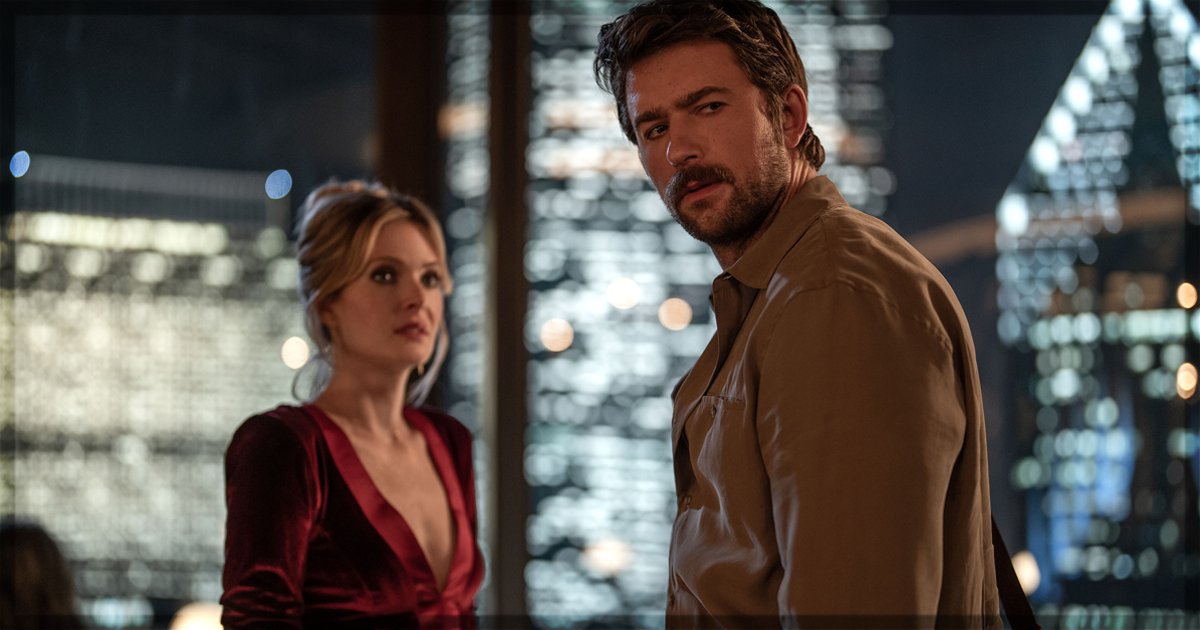Single-location mystery thrillers are one of the tried and true genres of stage and film. When executed well, they can be an edge-of-your-seat experience and a satisfying watch. Writer/Director Christopher Landon has a history of taking high-concept versions of setups like this and delivering a good time at the movies; Happy Death Day was a time loop crossed with a slasher, Freaky was a body swap crossed with a slasher, and Disturbia was Rear Window crossed with a teen drama about grief. Each of the films succeeds because they have a solid emotional core that they use their setting to explore, and with Drop, he has delivered again.
Meghann Fahy plays Violet, a mother and widow who is going on her first date with Henry (Brandon Sklenar), a kind man whom she has been messaging on a dating app. They settle in at a high-end restaurant, Palate, which is located on a high floor of a downtown building. They meet and exchange pleasantries and awkward small talk, but soon settle into something comfortable, and then Violet starts getting menacing messages “digi-dropped” (an obvious stand-in for Apple AirDrop for legal reasons) to her phone. The messages tell her three things: someone has her son, someone wants her to kill her date, and that someone must be in the restaurant with them.
Fahy and Sklenar are both excellent in their roles. Sklenar doesn’t have a lot to do, exactly, but playing perhaps the kindest and most patient date in the world is actually a difficult thing to pull off and have it feel natural, but he does make Henry feel like a real human being throughout. Fahy is anxious and unsure about being out at all, and once the mystery kicks into high gear, she carries the movie as she investigates who is tormenting her. She has to balance the first date anxiety with the desperation to save her son, and then, when the film reaches its climax, she gets one of the most satisfying moments of vindication of the year.
The whodunnit itself is clever; Landon and writers Jillian Jacobs and Chris Roach construct a room where everyone walks a line between being helpful or nefarious. Is it the overly friendly waiter (Jeffrey Self)? The flirtatious pianist (Ed Weeks)? The older man who is also on a first date (Reed Diamond)? Or maybe the protective bartender (Gabrielle Ryan)? Each has their moment, and while those who watch a lot of these stories will probably figure it out well before the reveal, that doesn’t make the reveal any less fun.
Drop is not the kind of movie that is going to change the world or win awards, but it is the kind of movie that you can watch a thousand times and enjoy it every time. The type of comfort movie you might put on if you’ve had a bad day, or even if you want to watch something reliable and fun. Sometimes that’s the best kind of movie there is.
Image/sound quality
As with the vast majority of UHD disks, the picture and sound quality for Drop is exquisite. Landon does some excellent work with the camera, lighting, and sound design in this film, and that really pays off in such high resolution.
In particular, there are several sequences where the lighting changes colour or switches to spotlights to highlight a side character or show Violet’s isolation in her situation. There are also numerous Dutch angles and subtle movements that help ramp up the tension, as well as moments where the camera moves to distract or obscure a more nuanced action.
The sound design also pays off if you have a system that can fully take advantage of it. Not only are there plenty of creative choices that reinforce the above, but in the big climax, there is so much detail in things, such as the sounds of glass breaking, that really bring extra life to the picture.
Special Features
Where the disk falters is in the special features. There is a full-length commentary by Christopher Landon, but there are only three short behind-the-scenes documentaries to enjoy, and while they’re fun, it feels a little lacklustre. Each of them digs into a specific aspect of the film’s production.
A Recipe For Thrills: Making Drop focuses on the production design and building of the film’s primary set, the restaurant. It’s a truly impressive thing they’ve made, and while the designs you see in the movie are intricate and feel like an authentic Michelin-starred restaurant, the stuff you don’t see is way more fascinating.
Killer Chemistry focuses on the cast and their interactions on and off screen. It’s a short delight, but it is just that: short.
A Palate for Panic takes a look at the food they created for the film, even going so far as to say the restaurant was essentially a functing one and that’s a cute line but it feels like something everyone was under contract to say.
The overarching issue here isn’t that these documentaries are bad; it’s that there aren’t enough of them. The ones we do get are very specific and well thought out, but it would have been nice to have more. More looking into the writing and the actual production of the film, rather than just highlights and marketing buzz. Hell, some storyboards or a gag reel might be nice too. It’s not fair to come down on Drop for this because it’s something that’s true of many disks, but such a fun film with such an interesting production design and a great cast could easily have more.
Conclusion
At the end of the day, Drop is an easy recommendation. It’s precisely the kind of well-executed high-concept thriller that is eminently rewatchable and deserves a place on your shelf as a result.


